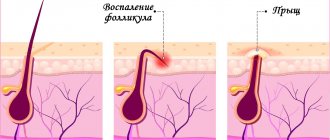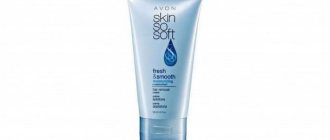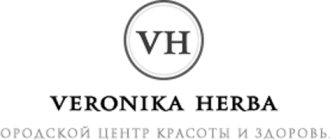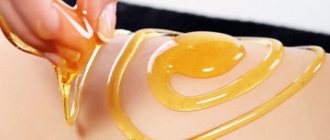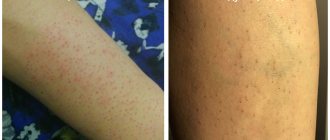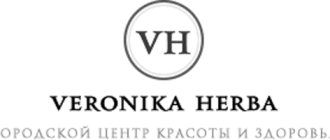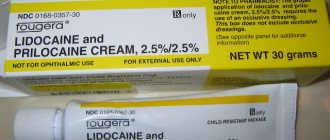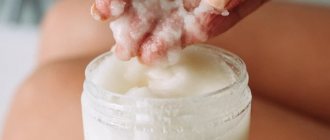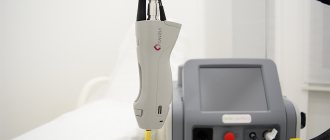Red, voluminous dots can form after a few days, when hairs that have already been thinned by manipulation (whether with a razor, sugar or wax) begin to emerge again. A thin hair under the skin forms a loop; the tip cannot break out, which can cause an inflammatory process.
Our cosmetologists know more than one solution to this problem, they will be happy to help you. But let's try to independently consider the reasons for this phenomenon and find a way out that will help you cope with the consequences of hair removal of this nature, even on your own at home.
Since hair removal is a very popular procedure, many people experience ingrown hairs after hair removal. There is nothing terrible about this if you start prevention in time. Hair most often begins to grow in on the legs and bikini area. If the process begins in the deep epilation zone, it is very unpleasant. There is no need to be shy or ashamed, as this is a common situation associated with the characteristics of the body, the structure of the hair and self-care after manipulation. At the same time, men face similar difficulties: hair can grow in the armpits, on the face (where the beard and sideburns are), and on the neck.
Make an appointment at the clinic on Vasilyevsky Island
Sign up
general information
Ingrown hair is a pathological condition in which the hair shaft grows backwards within the thickness of the skin.
This dermatological problem most often occurs in people with coarse or curly hair. Also, ingrown hairs often appear in the bikini area and other places where hair removal is regularly used. The condition may be accompanied by infection of the hair follicle, the formation of a cyst or abscess with purulent contents. Dermatologists believe that ingrown hairs can occur even with a single use of a razor. Other causes of the disease are often associated with epidermal renewal processes. Ingrown body hair is one of the most common dermatological problems. In the medical literature, this pathology is often called pseudofolliculitis. In men, the disease usually affects the hair in the beard growth area, and in women, ingrown hairs appear in the pubic area. If such a disease appears, you should immediately contact a dermatologist, since opening the abscess on your own can aggravate the situation. If a patient often encounters a problem, doctors recommend reconsidering the method of hair removal.
Treatments at home
To relieve inflammation and disinfect, boil chamomile or calendula and treat the area of inflammation. If pus has collected inside, it will need to be released and the wound should be washed. Why hair grows in after hair removal - we already understood what to do to eliminate it - now we’ll figure it out.
You will need antibacterial wipes or pads, rubbing alcohol or another disinfectant, tweezers, and a needle (to catch the end of the hair and lift it off the skin).
- Steam the area of inflammation (this can be done with a hot towel).
- Lubricate the inflamed, steamed skin with an antiseptic or wipe with antibacterial wipes.
- Pick up the hair and remove it with tweezers. Tweezers or a needle should pull out the hair, but under no circumstances injure the skin.
- Treat the manipulation area again with an antiseptic or disinfectant.
If you are lucky enough to detect an emerging problem before the inflammation begins, sometimes a good peeling is enough: you gently remove the top layer of rough epidermis and allow the hair to come to the surface. Pre-exclude hair removal in the treated area and do not do it for several days after, so that the skin restores its protective barrier.
How to deal with ingrown hairs after hair removal: therapeutic manipulations in the clinic
Good specialists will quickly and almost painlessly help you solve the problem. They can manually remove all ingrown hairs using the same principle as you do at home, only they will carry out the procedure professionally and competently. Or they will do professional skin cleaning in the area where the ingrowth has occurred. Sometimes one glance is enough for a cosmetologist to understand how he will help you cope with such consequences of hair removal. It is important to understand that it always takes into account the condition of your skin and its individual characteristics.
How to avoid ingrown hairs after hair removal
If you have experienced something similar before, you may know how to act and recover. But if this is the first time you heard about this and you have a fear that such a nuisance will affect you after hair removal, then there are no fewer questions. Surely, you are interested in learning how to prevent ingrowth and inflammation.
Skin and hair
Human skin is an independent organ that performs protective, metabolic, receptor and auxiliary functions. Thanks to the skin, the body gets rid of excess fluid, regulates tissue temperature, prevents the penetration of pathogenic microorganisms into organs and protects itself from other negative external influences. In different parts of the body, the skin has a different structure, but the essential parts of the organ are the epidermis, dermis and subcutaneous fat.
The epidermis is the outermost layer of the skin. The upper part of the epidermis is formed by keratinized cells that perform a barrier function. The formation of a specific pigment (melanin) in cells contributes to skin coloring. Below the epidermis is the dermis, which contains blood vessels, follicles, nerves, muscle fibers and glands. Sweat and sebaceous glands secrete their contents onto the surface of the skin. The lowest part of the organ is subcutaneous fat, which protects the underlying tissues from temperature changes and mechanical stress.
Hair is a derivative of the human skin. The center of growth of this structure is the hair bulb (follicle), located in the dermis. The constant division of cells in this zone contributes to the gradual growth of the rod in the outer direction. The cyclicity of hair growth is associated with the activity of follicle cells. In some areas of the skin there may be inactive bulbs.
Causes
The most common cause of ingrown hairs is self-depilation using a razor, wax or other product. In this case, only the outer shaft is removed while preserving the active hair follicle. With each depilation, the epidermis becomes more rigid, and the thickness of the hair shaft decreases. At a certain point, the hair can no longer break through the thickness of the epidermis, resulting in ingrowth of the hair shaft. Such a rod can grow in the direction of fatty tissue or remain in the follicle area, provoking an inflammatory process.
Causes:
- Incorrect hair removal technique. Doctors recommend entrusting depilation to professional cosmetologists. Using wax or other hair removal products at home increases the risk of developing pseudofolliculitis. Pseudofolliculitis can also appear when using an insufficiently sharp razor. In this case, depilation is accompanied by skin irritation, tissue swelling and the appearance of ulcers.
- Curly hair. After removing the superficial part of such hair, the shaft begins to curl under the skin and grow in the opposite direction.
- Rigid rods. The problem area is rarely represented by vellus hair. Most often these are the legs, neck and pubis.
- Improper skin care after depilation. Cosmetologists recommend using lotion or a special cream after sugaring. Softening and moisturizing the skin reduces the risk of inflammation.
- Frequent shaving in one place. Thus, depilation even with the appearance of small stubble increases the risk of developing pathology.
The inflammatory process after ingrown hair occurs due to the activity of the immune system. The body's defense system identifies the rod as a foreign structure, resulting in the release of inflammatory mediators. Pathogenic and opportunistic bacteria present in the skin can cause an infectious process in the area of the inflamed follicle.
The best lotions against ingrown hairs
The lotion has a light, non-greasy consistency, which is perfect for sensitive and normal skin that does not need extra nutrition. Cosmetology recommends choosing this form of release in the summer. This is also a good option for high fat content, since 70-80% is water based. This year's leaders were 2 lotions against ingrown hairs.
Depilflax
The review opens with a popular Spanish drug based on salicylic acid, which is suitable for any type of epidermis. Regular use not only removes and prevents the problem in question, but also softens and smoothes the skin.
The active formula includes 2 components. The first is salicylic acid, it exfoliates dead cells and allows ingrown hairs to get out of the pores. The second is urea, which guarantees intense softening and moisturizing. The lotion also has antioxidant properties, improves color and evens out skin texture.
Packaging – 125 ml bottle with spray. The consistency is liquid, with a pleasant refreshing aroma. Does not leave stickiness, slightly cools. It is advisable to apply for 2 weeks for maximum results.
Advantages:
- Two strong ingredients;
- Intensive moisturizing, softening;
- Relief improvement;
- Evening out skin tone;
- Easy to use;
- Cooling.
Flaws:
- Alcohol;
- Cumulative effect.
The first results can be observed after 5-7 days of regular application. Due to the presence of alcohol, the lotion works as an antiseptic. Lotion is allowed 24 hours after depilation procedures, not earlier.
Start Epil 2 in 1 with walnut oil and tea tree extract
The second position is occupied by an organic 2 in 1 lotion from the Russian manufacturer of professional cosmetics for sugaring “Aravia Professional”. This not only prevents ingrown hairs, but also slows down their growth, which reduces the frequency of depilation.
The active formula includes 4 ingredients. Tea tree extract disinfects, relieves inflammation, and soothes the skin. Papain enzyme works like an enzyme peel, it deeply cleanses and exfoliates. Walnut oil nourishes and softens tissues; in addition, it is a natural depilatory agent that slows down hair growth. Glycerin is an effective humectant.
Packaging: 160 ml bottle with pump dispenser. The consistency is very similar to thermal water. Liquid, transparent, slightly foaming. It is quickly absorbed and does not leave a greasy film. Almond aroma, refreshing.
Advantages:
- Organics;
- Prevention of irritation;
- Slowing hair growth;
- Deep hydration;
- Peeling effect;
- Convenient dispenser.
Flaws:
- Requires regular use;
- A little expensive.
The effect is also cumulative, so course use is recommended daily for 10-15 days. You should start the next day after depilation. Reviews confirm that the product really slows down the appearance of new vegetation.
Symptoms
Externally, an ingrown hair resembles a small pimple or abscess with a grayish-white lump in the center. Sometimes, in the area of the abscess, the hair shaft is visible through a thin area of skin. Most often, pseudofolliculitis appears in the beard growth area in men, in the pubic, axillary and anogenital area. In particular, any place where coarse, curly hair forms can become an area where pseudofolliculitis appears.
As a rule, abnormal hair growth occurs within a few hours after depilation. First, redness of the skin occurs in the shaving area. After about a few days, a painful lump forms in the hair growth area. Infection of the formed cyst can be manifested by an increase in the abscess and severe pain. In some cases, the ingrown hair comes out on its own with the release of pus. Puncture of a cyst on your own increases the risk of infection.
Other possible signs:
- severe itching in the area of hair growth;
- darkening of the skin (hyperpigmentation);
- local increase in body temperature;
- discharge of grayish-white liquid in the hair growth area.
Sometimes several ingrown hairs appear in one area at the same time.
Preventive actions
To prevent the development of pathological ingrown hairs, it is recommended to follow easy-to-follow rules for actions to eliminate unwanted hair structures:
- Before shaving or hair removal, be sure to steam the skin and clean the surface using a scrub;
- carry out shaving manipulations in the direction of growth of hair structures and promptly change the razor used;
- After the procedure, moisturize the skin, applying a product that suppresses active hair growth.
In addition to the above, you should not carry out manipulations before going outside; the best time to carry out the procedure is the evening interval before bedtime, during which the skin tissues regenerate and are fully restored without the possibility of pathogenic influences coming into contact with sensitive skin.
What symptoms do you see a surgeon for:
- Presence of hernial protrusion
- Daggering pains in the abdomen
- Bloating
- Pain in the right hypochondrium
- Bitterness in the mouth
- Nausea
- Presence of neoplasms on the skin
- Swelling and redness of the skin
- Bone fractures and bruises
- Wounds of any location
- Vomit
- Enlarged and painful lymph nodes
Prices:
| Code | Name of service | Prices |
| 1 | Initial appointment | 1200 |
| 2 | Repeated appointment | 900 |
| 3 | Calling a surgeon to your home | 3500 |
| 4 | Abdominal ultrasound | 2200 |
| 5 | Ultrasound of veins and vessels | 2400 |
| 6 | Doppler 2-3 trimester | 1200 |
| 7 | Rectoscopy | 1500 |
Diagnostics
If signs of pseudofolliculitis appear, you should make an appointment with a dermatologist. The doctor will ask the patient about complaints and hair growth patterns. In most cases, an external examination of the problem area is enough to make a diagnosis, but sometimes a dermatologist needs to exclude other skin pathologies with similar signs.
Additional examinations:
- Dermatoscopy is an instrumental way of examining the skin using multiple magnification. The doctor may use a manual scope or an automated digital dermatoscope. With this examination, the dermatologist evaluates the condition of the skin and looks for specific signs of pseudofolliculitis, such as a barely noticeable tip of the hair shaft under the skin.
- Laboratory examination of the contents of the abscess. In rare cases, such a procedure is prescribed for the frequent appearance of a follicular abscess in one area. The specialist needs to clarify which pathogen is causing the infection.
During the diagnosis, the dermatologist excludes the presence of diseases such as folliculitis, pyoderma, acne and hyperkeratosis. Additional examinations can improve the treatment of the disease.
What is the best remedy for ingrown hairs?
Our team has presented to your attention the names of the 10 leaders of the current year. These are the customers' choice, products that have received high ratings and the most positive reviews. What to buy from all this is a purely individual decision. Having compared all the pros and cons, Vyborexperta.ru recommends:
- Depilflax - the best composition for softening hard hairs and tight skin, pleasant cooling and smoothing;
- Depiltouch with fruit acids – 3 types of AHA acids at once, providing peeling, lightening, and healing of the body;
- Sherris is an effective preparation in the form of enzyme powder, the best organoleptic properties;
- Cristaline NG is a light, instant action gel based only on natural ingredients
- Start Epil with seaweed extracts is a gel-based scrub with a powerful exfoliating abrasive that does not injure the skin;
- Bielita Delicate care is the people's choice, the best combination of price and quality.
To summarize, we strongly recommend combating the problem of incorrect depilation. This is a long, rather complex procedure that requires a regular, systematic approach. But only in this way can the skin and vegetation on it be restored to normal condition. Avoid serious consequences and aesthetic defects.
How to remove an abscess?
To prevent the development of complications, it is recommended to consult a professional. The doctor performs an antiseptic treatment and carefully removes the hair shaft using tweezers. If an abscess occurs, the abscess is surgically opened and the accumulated exudate is removed. After the procedure, the doctor will prescribe medications to the patient to treat the skin.
Medicines used:
- Medicines that help remove dead cells in the epidermis. These are local products based on vitamin A derivatives. The dermatologist may recommend drugs such as Renova or Retin-A to the patient.
- Local remedies to relieve the inflammatory process. These are gels and ointments based on corticosteroids. Anti-inflammatory therapy can be carried out before removing an ingrown hair.
- Medicines to fight infection. The dermatologist prescribes topical medications to the patient based on antibiotics, salicylic acid, benzoyl peroxide and other substances. If necessary, the doctor prescribes a course of antimicrobial therapy using tablets.
- Additional methods for improving skin condition. These are moisturizing ointments, scrubs, lotions and other products. It is recommended to discuss the selection of medications for a specific skin type with a cosmetologist.
If follicular ulcers occur frequently, the dermatologist prescribes the patient a consultation with an endocrinologist.
Rating of products for ingrown hairs
Today, many methods and preparations have been developed to remove ingrown hairs. But not everyone guarantees the expected result. We studied all the nuances of dealing with such a defect, familiarized ourselves with the recommendations of cosmetologists, dermatologists, and beauty experts. Having selected reliable manufacturers, we focused on the most popular products.
When ranking positions in the top, we compared the following characteristics:
- Release form;
- Compound;
- Healing properties of the active formula;
- Intended for dermis type;
- Organoleptic properties;
- Subtleties of application;
- Packaging format;
- Volume, cost efficiency;
- Performance;
- Price, manufacturer's reliability.
The result of the comparative analysis was a top list of 10 positions. These are the best-selling drugs of the current year and have received many positive reviews. For convenience, the rating was divided into 5 categories according to the form of release - lotions, creams, powders, gels, scrubs. Real user experience determined the strengths and weaknesses of each nominee.
Complications
Adverse consequences may occur if pseudofolliculitis is removed incorrectly on your own or if ingrown hairs occur frequently.
Possible complications:
- Penetration of pathogenic bacteria into an ingrown hair cyst with the formation of an abscess. The abscess may gradually increase in size. The infection spreads with the formation of an extensive inflammatory process.
- Scarring of the skin in the area of ingrown hairs. When an abscess opens on its own or there is extensive inflammation, a focus of connective tissue growth (scar) forms in the wound. Scarring of the skin is a cosmetic problem.
- Changes in skin color among ingrown hairs and the occurrence of recurrent pseudofolliculitis.
Professional treatment of the disease reduces the risk of complications.
The best gels against ingrown hairs
The gel completely excludes fats and oils from the formula; in addition, in terms of acid-base indicators, it is very close to the pH of the skin. Its texture is easier to distribute, absorbs faster, and does not cause comedogenicity. According to Vyborexperta.ru, the best in the beauty products market were 2 nominees who received high customer ratings.
Gloria
On this line of our top there is an intensive gel that reduces the likelihood of ingrown hairs. It is suitable for all areas of the body, including especially delicate ones. The manufacturer is a successful Russian company in the field of cosmetology “Gloria”.
The active formula consists of a combination of 3 acids - malic, lactic and salicylic. They exfoliate the upper layer of the epidermis, increase elasticity, and even out the relief. In addition, they have an anti-inflammatory and antibacterial effect, maintain hydrobalance, and prevent dryness and flaking.
Packaging – plastic transparent bottle 110 ml with a vacuum dispenser. The liquid texture is delicately distributed and quickly absorbed without irritation. Chemical peeling cleanses and enhances renewal without causing dryness.
Advantages:
- Acid peeling;
- Mitigation;
- Maintaining hydrobalance;
- Antibacterial, anti-inflammatory effect;
- Economical consumption;
- Inexpensive.
Flaws:
- Fragrance;
- Short shelf life.
The optimal frequency of application is 2-3 times a week. If inflammation is severe, then it can be done more often. The first noticeable changes can be observed after 1-2 weeks of use. It is worth considering that after opening the gel is good for only 6 months.
Cristaline NG
A good care product after depilation of delicate areas is presented by the Italian brand “Cristaline”. The main difference between the nominee is the instant result. Light texture cools, tones, eliminates all painful sensations.
The active formula is natural ingredients. This is a papaya extract that helps accelerate cellular renewal and also stops the growth rate in the follicles. It is also a complex of plant extracts - thuja, sage, hops, mistletoe. Their chemical formula improves the internal processes of the epidermis.
Packaging – plastic bottle 250/500 ml. The texture is liquid, it perfectly moisturizes, soothes the dermis, gives a feeling of smoothness, and makes dark spots and scars almost invisible.
Advantages:
- Instant action;
- Reduction of body hair;
- Epidermis care;
- Comfortable texture;
- Cooling, toning;
- Lightening dark areas.
Flaws:
- Inconvenient dispenser;
- Specific smell.
Among all the previously presented nominees, improvements are noticeable much faster here. The gel is perfectly absorbed, fights irritation, and prevents side symptoms from shaving in the future.
What to do to prevent it?
Simple recommendations from a dermatologist can reduce the risk of ingrown hairs.
Methods for preventing the disease:
- Using special lotions and gels before and after shaving. These remedies help get rid of tissue inflammation.
- Replacing shaving with laser hair removal or another method of radical hair removal.
- Thoroughly steam the skin before using the depilator.
- Using moisturizers and scrubs.
- Treatment of the skin with antiseptics for frequent occurrence of ulcers.
- Food with sufficient vitamins and microelements.
To develop an individual plan for the prevention and treatment of ingrown hairs, it is recommended to consult a dermatologist. The specialist will help the patient get rid of the problem safely.
How to choose a remedy for ingrown hairs
Deeply ingrown hair always causes irritation, inflammation, darkening, and can even leave scars. To prevent this, it is important to use lotion, cream, gel and/or scrub in a timely manner. Choose such cosmetics according to several criteria - type of product, skin type, composition, effectiveness.
Type of product
A special cosmetic product will help you get rid of such an aesthetic defect after careless sugaring or shaving. It could be:
- lotion is water-based, light, non-greasy, the best solution to take care of your body in the summer;
- cream - the basis is nourishing, oily components that provide deep hydration and softening;
- powder - a kind of talc, but for dilution with water, after which a drying foam is obtained;
- gel - there are no oily or greasy components, the texture is maximally adapted to the pH of the dermis, the texture quickly penetrates deep into the skin and does not clog pores.
- scrub is a combination of a soft oily base with abrasive particles that comprehensively exfoliate, cleanse and soften the epidermis.
Which one is better depends on what skin type you have. Therefore, let's move on to consider this point.
Skin type
Any cosmetic product on the label indicates what type of dermis it is intended for. If your skin is prone to oily skin, a gel, powder, or scrub with a hard abrasive would be appropriate. If dry, consider cream option. For increased sensitivity, a water-based lotion with natural content is suitable.
Compound
The main function of such products is exfoliation, softening the upper layer of the dermis, and moisturizing. Formulas that include active moisturizers of natural origin can cope with such tasks. It’s good if there are acids there, they work on the principle of peeling and brighten. Avoid products with alcohol, parabens, sulfates, preservatives and dyes.
Efficiency
It is quite possible to determine in absentia whether this or that product will be effective after shaving. To do this, you need to study the beneficial properties of the ingredients included in the formula, as well as read reviews from previous customers, and look at beauty reviews from experts. In the end, you can read the guarantees and promises of the manufacturer itself.
